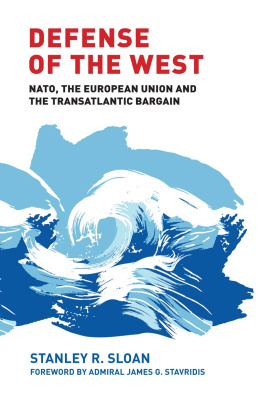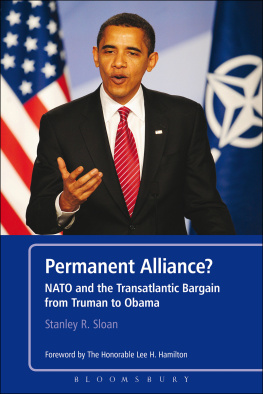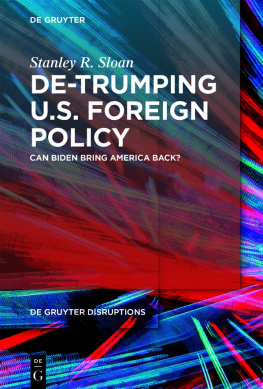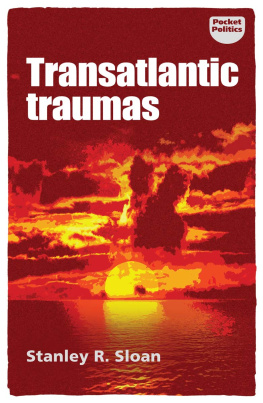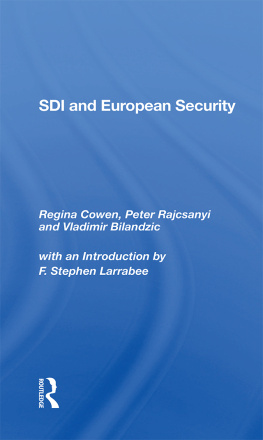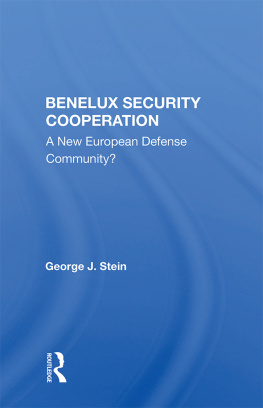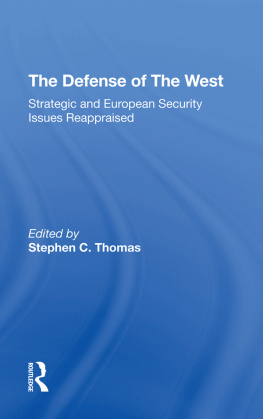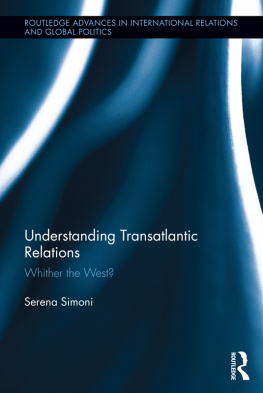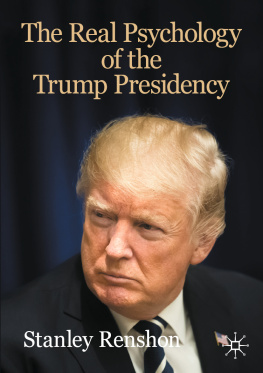Copyright Stanley R. Sloan 2016
The right of Stanley R. Sloan to be identified as the author of this work has been asserted by him in accordance with the Copyright, Designs and Patents Act 1988.
Published by Manchester University Press
Altrincham Street, Manchester M1 7JA
www.manchesteruniversitypress.co.uk
British Library Cataloguing-in-Publication Data
A catalogue record for this book is available from the British Library
Library of Congress Cataloging-in-Publication Data applied for
ISBN 978 1 5261 0575 2
First published 2016
The publisher has no responsibility for the persistence or accuracy of URLs for any external or third-party internet websites referred to in this book, and does not guarantee that any content on such websites is, or will remain, accurate or appropriate.
Typeset in 10/12 Photina by
Servis Filmsetting Ltd, Stockport, Cheshire
It is a pleasure to have the opportunity to follow in the footsteps of the Honorable Lee Hamilton and the late General John Shalikashvili in contributing a foreword to this new edition of Stan Sloans perceptive analysis of the past, present and future of the transatlantic security relationship. My service as NATOs senior military commander left me convinced that a healthy trans-atlantic alliance is not only key to the security of the United States, Canada, and their European allies, but also is an irreplaceable component of a stable international system. The alliancewith NATO and the European Union at its institutional corehas served the United States and its allies well since NATOs founding in 1949. The alliance was an essential defender of the values and interests shared by the transatlantic democracies at a time when Soviet communism threatened to spread the power and political system of a dictatorial Soviet Union across Europe. At the end of the Cold War, NATO sensibly did not disband, as many observers had proposed, but rather preserved the structures and processes of political/military cooperation that allied leaders wisely judged would be needed in the years ahead, even in the absence of a Soviet threat. The allies then opened membership in both NATO and the European Union to those countries willing and able to take on the demands of membership, including establishing functioning democratic political systems operating on the rule of law, protecting individual liberties, and developing free market economic systems. NATO played an important role in the response to the 9/11 attacks on the United States by establishing and leading the International Security Assistance Force in Afghanistan. Today, it provides a framework for coordinating responses to the new threats posed by a dissatisfied Russian Federation and a marauding Islamic State. The transatlantic alliance remains the foundation for a defense of the West.
The concept of defense of the West provides the framework for this updated and substantially revised assessment of the transatlantic bargain between North America and Europe. The author is one of Americas most respected analysts of transatlantic relations, having for years provided balanced and objective assessments in his capacity as an analyst for the Central Intelligence Agency and then for over two decades as the leading expert on NATO and European security for the Congress as a Senior Specialist at the Congressional Research Service. In this volume, he applies the skills honed over those many years to produce a historical analysis of transatlantic relations that should help guide the study of the topic for many years ahead.
This eminently accessible analysis should clearly be read not just by students but also by the successor leaders who will soon take their place in a new American administration, as well as in those of other NATO and EU states. It is equally a valuable read for concerned American and European citizens who want to base their foreign policy and defense perspectives on the thoughtful work of an authoritative expert rather than on the headlines of the day.
Understanding how and why countries act as they do cannot be understood without an appreciation of the historical and other factors that influence their decisions. In its historical treatment of the Cold War period, this volume illustrates how multiple factors shaped NATO and EU member state behavior in previous decades. These insights also provide essential perspectives to help the reader understand and anticipate how the United States, its allies and partners might act in the future.
The burden-sharing issue between the United States and its allies has troubled alliance relations from the very beginning. Without seeking excuses for the less-than-stellar performance of most European allies in this regard, the author argues convincingly that burden-sharing is a natural issue to arise among democratic states, all of whose leaders are trying to achieve the highest levels of security possible at the lowest possible cost. This inevitably produces a degree of free riding by less powerful allies, and significant burdens and responsibilities carried by more powerful ones. Like many issues in alliances, this is one that has to be managed successfully but is not likely to be solved.
NATO is frequently described as just a military alliance. This descriptor, however, is so far off the mark to be almost laughable. Everything that is accomplished in the transatlantic security framework is done as the result of political judgments, communicated in discussions and negotiations, and finalized in compromises among sovereign states. The process is highly political, even when outcomes are presented as military decisions. Today, as Stan Sloans analysis makes clear, the alliance is as political as ever.
This book is particularly valuable in looking at the relationship between the external threats now facing the alliance and the internal challenges that complicate responses to those threats. The direct threats to Western values and interests include those posed by Russias revisionist policies and the violent extremism of the Islamic State and related groups who hope to change the status quo through the use of force. Internal challenges involving leadership and followership shortcomings, economic shocks and energy supply vulnerabilities, spillover effects of turmoil in the Middle East and North Africa, and illiberal tendencies in the politics of some European countries are among the factors making transatlantic security relations complex and contentious.
This book leaves no doubt about the authors judgement: the transatlantic alliance, with all its flaws, remains an essential vehicle for the defense of Western values and interests. But the analysis also opens the door for readers to contemplate different ways of protecting those values and advancing those interests. Previous editions of Stan Sloans analyses have helped educate several generations of students, experts, and leaders. I recommend this new volume in the strongest terms possible. It is an invaluable contribution to the on-going debate about the future of transatlantic relations.
James G. Stavridis
Admiral, US Navy (ret)
Former Supreme Allied Commander, NATO
Dean, The Fletcher School of Law and Diplomacy,
Tufts University Boston, Massachusetts


